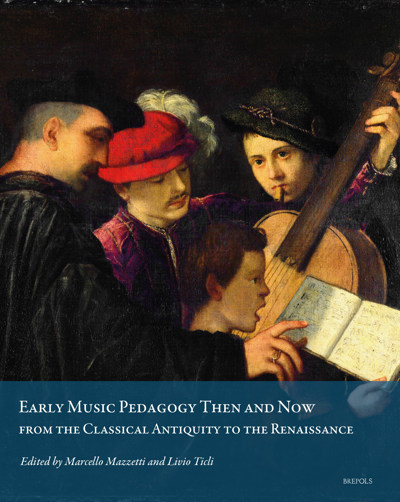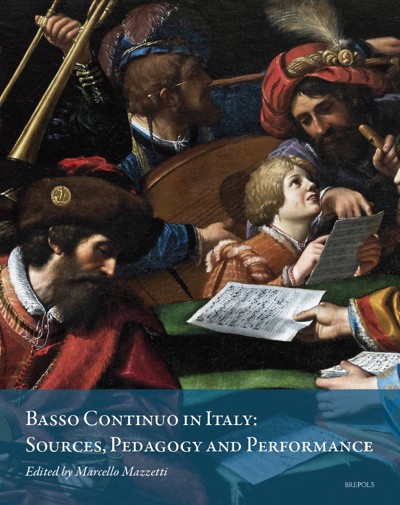
Figured Bass Accompaniment in Europe
Livio Ticli (ed)
- Pages: xiv + 424 p.
- Size:210 x 270 mm
- Illustrations:43 b/w, 12 tables b/w., 75 musical examples
- Language(s):English, Italian
- Publication Year:2024
- € 120,00 EXCL. VAT RETAIL PRICE
- ISBN: 978-2-503-60851-8
- Hardback
- Available
Sixteen internationally-renowned scholars map the figured bass accompaniment in Europe through a wide timespan: from the early-seventeenth-century Germany to late continuo realisations by Johannes Brahms and Robert Franz.
Livio Ticli is a musicologist, singer and player (keyboards and harp). He teaches Basso Continuo, Renaissance Singing and Ornamentation at the Istituto Italiano di Musica Antica (co-chairing Brescia Early Music Department); History of Music at Alessandria Conservatory and Solmisation Practice at Vicenza Conservatory. He collaborates with editorial boards such as the Tasso-in-Music Project (Massachusetts and Stanford University), and he is general editor of the book series Antichi Maestri (LeMus) and Musica Incarnata (Brepols).
At the very end of his new and charming chapter included in this volume, Thomas Christensen sensuously claims that for each generation, figured bass has something new to say, though it rarely gives up its secrets without a fight. This book, therefore, attempts to do justice to the fight lead by sixteen internationally-renowned scholars who ventured mapping the figured bass accompaniment in Europe through a wide timespan: from the early-seventeenth-century Germany to late continuo realisations by Johannes Brahms and Robert Franz. The volume also addresses several issues such as different ways to sketch and write extensively the instrumental accompaniment, its rendition into practice and how to teach and apply formulas for improvising (and realising) a contrapuntal texture over the bass. For the first time, counterpoint, basso continuo and partimento are put into dialogue, overcoming terminological antinomies and underlining the points of continuity amongst different accompaniment practices in France, Germany, England and Spain for over three centuries. Case studies shed some lights on accompaniment of specific instruments such as cello and guitar.
Livio Ticli, Introduction: Figured Bass in the European Tradition: Continuities and Changes of a Practice
Through Alps and Pyrenees To the Sea: Continuity and Discontinuity in Performance Practice
David Chung, The Significance of the Preludes with Figured Bass in F-Pn Vm8 1139 for Keyboard Pedagogy in Early Eighteenth-Century France
Clotilde Verwaerde, The Three-voice Texture in Eighteenth-Century French Continuo
Marie Demeilliez, The «Encyclopédie ou Dictionnaire raisonné des sciences, des arts et des métiers» (1751-1772): A Source for Basso Continuo Accompaniment in Eighteenth-Century France
Isaac Alonso de Molina, «Acompañamientos con las llamadas del Baxo y lo que se puede tocar sobre cada uno de ellos»: partimenti diminuiti in Manuscript M/1188 of the Biblioteca Nacional de España (Madrid)
Michael Fuerst, Hieronymus Praetorius, Multiple-Bass Notation in Organ Parts, and Continuo Performance Practices of Polychoral Music in the Hanseatic Cities of Northern Europe
Connected by Strings: Cello Accompaniment Performance Practice
John Lutterman, Partimento, German Thoroughbass Practice, and Improvised Solo Performance on the Cello
Hilary Metzger, National Styles in Lower String Accompaniment of Secco Recitative in the Late 18th and Early 19th Centuries
From the Page to the Performance through Space and Time
Valeria Mannoia, Per ogni tradizione il suo basso. I bassi seguenti italiani in alcune antologie tedesche del Seicento
Francesca Mignogna, Il basso continuo nelle composizioni per i defunti di Pierre-Louis Pollio (1724-1796). Uso, notazione e problematiche relative all’edizione moderna della partitura
Anthony Abouhamad, The Principles of Partitura Playing: An Introduction to Basso Continuo Instruction and Practice in Eighteenth-Century Salzburg
Martin Ennis, «Quod licet Bacho non licet Francisco»: A New Perspective on the Continuo Realisations of Johannes Brahms and Robert Franz
Basso Continuo and Partimento as a Pedagogical Tool Then and Now
Thomas Christensen, Figured Bass: Then and Now
Stephan Lewandowski, «With regard to the Now Prevailing Taste in Music»: The Music Theoretical Work of Johann Gottfried Vierling (1750-1813)
Matthew Mazanek, Improvisation Pedagogy in Nineteenth-Century Guitar Education
Justin Ratel, Repurpose and Transformation of an Educational Material: Figured Bass as a School Practice in the Early Years of the Paris Conservatory
Thomas Allery, Thorough Bass Made Easy: The Pedagogical Value of Figured Bass in Musical Education Today
Livio Ticli, Basso Continuo as a «Concertato» Practice: Vocal-Instrumental Improvisation, Ornamentation and Counterpoint
Index of Names


